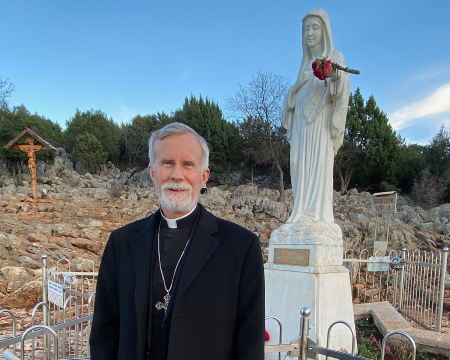We ask you, humbly: don't scroll away.
Hi readers, it seems you use Catholic Online a lot; that's great! It's a little awkward to ask, but we need your help. If you have already donated, we sincerely thank you. We're not salespeople, but we depend on donations averaging $14.76 and fewer than 1% of readers give. If you donate just $5.00, the price of your coffee, Catholic Online School could keep thriving. Thank you.Help Now >
Tournai
FREE Catholic Classes
DIOCESE OF TOURNAI (Latin TURNACUM, TORNACUM; Flemish, DOORNIJK — TORNACENSIS)
Diocese in Belgium. As early as the second half of the third century St. Piat evangelized Tournai; some writers represent him as the first bishop, but this cannot be proved. Towards the end of the third century the Emperor Maximian rekindled the persecutions, and St. Piat suffered martyrdom. The great barbarian invasions began shortly afterwards, and a wave of Germanic paganism mingled with the Roman paganism, to the destruction of all Christian life. This lasted from the end of the third century till the end of the fifth. But with the progress of the Frankish race Clodion established himself at Tournai; Childeric, his successor, died there in 481. St. Remigius profited by the good will of the Frankish monarchy to organize the Catholic hierarchy in the north of Gaul. He confided the Diocese of Arras and Cambrai to St. Vaast (Vedastus), and erected the See of Tournai (c. 500), appointing as its titular Eleutherius. It was probably its character of royal city which secured for Tournai this premature creation, but it soon lost its rank of capital by the departure of the Merovingian court. Nevertheless it kept its own bishops for nearly a century; then about 626 or 627, under the episcopate of St. Achar, the sees of Tournai and Noyon were united, retaining separate organizations. Tournai then lost the benefit of a privileged situation, and shared the condition of the neighbouring dioceses, such as Boulogne and Therouanne, Arras and Cambrai, where the same titular held both sees for five hundred years. It was only in 1146 that Tournai received its own bishop.
We ask you, humbly: don't scroll away.
Hi readers, it seems you use Catholic Online a lot; that's great! It's a little awkward to ask, but we need your help. If you have already donated, we sincerely thank you. We're not salespeople, but we depend on donations averaging $14.76 and fewer than 1% of readers give. If you donate just $5.00, the price of your coffee, Catholic Online School could keep thriving. Thank you.Help Now >
Among its bishops may be mentioned: St. Eleutherius (beginning of sixth century); St. Achar (626-27 — 1 March, 637-38); St. Eloi (641-60); Simon de Vermandois (1121-46); Walter de Marvis (1219-51), the great founder of schools and hospitals ; Etienne (1192-1203), godfather of Louis VII and minister of the queen; Andrea Chini Malpiglia (1334-42), cardinal and papal legate ; Guillaume Filastre (1460-73), chancellor of the Golden Fleece; Michel de Warenghien (1283-91), a very learned doctor; Michel d'Esne (1597-1614), the author of several works. During the Spanish domination (1521-1667) the see continued to be occupied by natives of the country, but the capture of Tournai by Louis XIV in 1667 caused it to have as bishops a series of Frenchmen : Gilbert de Choiseul du Plessis-Praslain (1670-89); François de La Salle de Caillebot (1692-1705); Louis Marcel de Coëtlogon (1705-07); François de Beauveau (1708-13). After the Treaty of Utrecht (173) the French were replaced by Germans: Johann Ernst, Count of Löwenstein-Wertheim (1713-31); Franz Ernst, Count of Salm-Reifferscheid (1731-1770); Wilhelm Florentine, Prince of Salm-Salm (1776-94).
It will be readily understood that the union of the see with Noyon and the removal thither of the seat of the bishopric had favoured the growth of the power of the chapter. The privilege possessed by the chapter under the old régime of being composed only of nobles and scholars necessarily attracted to it the most distinguished for birth and learning. Illustrious names of France and Belgium are inscribed in the registers of the archives or on the tombstones of the cathedral. The cathedral, 439 feet long by 216 feet wide, is surmounted by 5 towers 273 feet high. The nave and transept are Romanesque (twelfth century), and the choir is primary Gothic, begun in 1242 and finished in 1325. Originally the boundaries of the diocese must have been those of the Civitas Turnacensium mentioned in the "Notice des Gaules". The prescriptions of councils and the interest of the Church both favoured these boundaries, and they were retained throughout the Middle Ages. The diocese then extended along the left bank of the Schelde from the Scarpe to the North Sea, with the exception of the Vier-Ambachten (Hulst, Axel, Bouchaute, and Assenede), which seem to have always belonged to the Diocese of Utrecht. The Schelde thus formed the boundary between the Dioceses of Tournai and Cambrai, cutting in two the towns of Termonde, Ghent, Oudenarde, and Tournai itself. The shore of the North Sea between the Schelde and the Yser was wholly included within the perimeter. On the other side of the Yser was the Diocese of Thérouanne, which bordered Tournai as far as Ypres. There began the Diocese of Arras , which bordered Tournai as far as the confluence of the Scarpe and the Schelde at Mortgne, France. This vast diocese was long divided into three archdeaneries and twelve deaneries. The archdeanery of Bruges comprised the deaneries of Bruges, Ardenbourg, and Oudenbourg; the archdeanery of Ghent, the deaneries of Ghent, Roulers, Oudenarde, and Waes; the archdeanery of Tournai, the deaneries of Tournai, Seclin, Helchin, Lille, and Courtrai.
In 1559 in order to wage more successful war against Protestantism, King Philip II of Spain obtained from Paul VI the erection of a series of new dioceses. The ancient Diocese of Tournai was divided, nearly two-thirds of its territory being taken away. The outlines of the archdeaneries of Bruges and Ghent formed the new dioceses of Bruges and Ghent, and six parishes passed to the new Diocese of Ypres. These conditions lasted until the beginning of the nineteenth century. The French Revolution created the Department of Jemappes, which in 1815 became the Province of Hainault, whose boundaries followed those of the Diocese of Tournai, after a concordat between the plenipotentiaries of Pius VI and the consular government of the republic. The Bishop of Tournai retained only two score of the parishes formerly under his jurisdiction, but he governed on the right bank of the Schelde a number of parishes which, prior to the Revolution, belonged to the Diocese of Cambrai (302), Namur (50), and Liège (50).
The Diocese of Tournai, with 1,240,525 inhabitants, has 537 parishes, divided into 33 deaneries: Antoing (21 parishes ), Ath (12), Beaumont (17), Beloeil (15), Binche (18), Boussu (18), Celles (14), Charleroi (18), Châtelet (27), Chièvres (23), Chimay (22), Dour (18), Ellezelles (6), Enghien (12), Fountain-L'Evêque (20), Frasnes-lez-Buissenal (14), Gosselies (20), La Louviere (15), Lens (23), Lessines (12), Leuze (17), Merbes-le-Château (17), Mons (Ste-Elisabeth, 9), Mons (Ste-Waudru, 10), Pâturages (17), Péruvelz (12), Roeulx (16), Seneffe (21), Soignies (11), Templeuve (13), Thuin (16), Tournai (Notre-Dame, 14), Tournai (St-Brice, 13).
Eight diocesan colleges prepare young men for theological studies in a seminary, or for a liberal course in a university.
We ask you, humbly: don't scroll away.
Hi readers, it seems you use Catholic Online a lot; that's great! It's a little awkward to ask, but we need your help. If you have already donated, we sincerely thank you. We're not salespeople, but we depend on donations averaging $14.76 and fewer than 1% of readers give. If you donate just $5.00, the price of your coffee, Catholic Online School could keep thriving. Thank you.Help Now >








 Daily Readings for Saturday, April 20, 2024
Daily Readings for Saturday, April 20, 2024 St. Marian: Saint of the Day for Saturday, April 20, 2024
St. Marian: Saint of the Day for Saturday, April 20, 2024 Children's Prayer For Parents: Prayer of the Day for Saturday, April 20, 2024
Children's Prayer For Parents: Prayer of the Day for Saturday, April 20, 2024


